
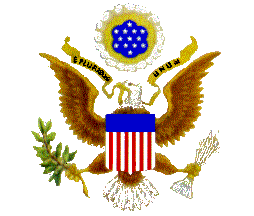
 |
 |
The present-day 48 contiguous states were occupied by Native American people (American Indians) from about 15,000 years ago. They travelled from Eurasia via a land bridge from Alaska (where they are known as Inuits or Eskimos) and spread southward. European settlers arrived from the 16th century onwards, eventually creating the present-day country (starting with 13 colonies, growing to the present-day 50 states as shown in the map below (courtesy of Wikipedia). Hawaii, the 50th state, was inhabited by Polynesian people until white settlement.
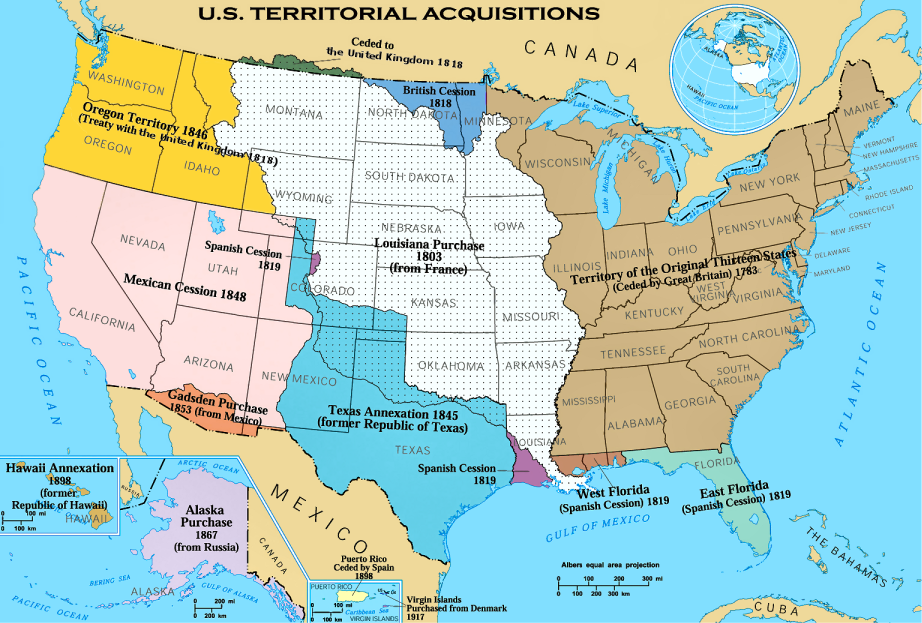
 |
Before European settlement circumcision was normal among the Inuit in the north of the country. Circumcision knife with slate blade and bone handle. Victoria land, North America (Photograph courtesy Wellcome Library, London). |
| The extent to which it was practised by other Native American nations is not clear, though it seems clear that at least some did circumcise. Some of the pre-Columbian civilizations were quite advanced, with towns, villages and rigid social structures. The illustration shows a reconstruction of the Mississippian Kinkaid site. It seems probable that, like the Aztec civilization further south, and the Central American Mayas, they practised circumcision. | 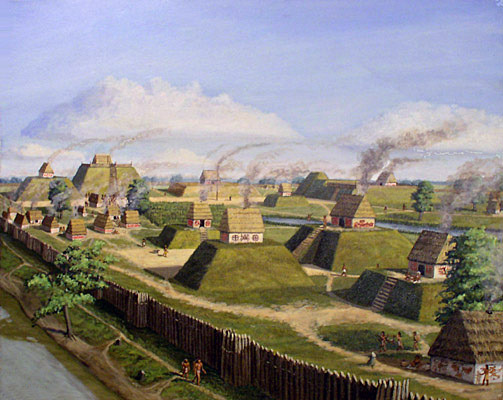 |
Hawaii, being a Polynesian nation (and one with a very sophisticated culture) did circumcise, probably with the simple dorsal slit which many Polynesian nations used.
In the 16th century there were Spanish settlements in Florida and French colonists (Akkadians, now called Cajuns) in what is now Louisiana. Neither practised circumcision, and the Spanish actively opposed it. Early in the 17th century English settlers, Puritans escaping religious persecution, settled in Virginia. For them circumcision was simply a Jewish practice, and it was inconceivable that Christians would circumcise.
As we all know, the British colonists eventually became dominant. While they didn't oppose circumcision with the zeal of the Spaniards (after all, most of them were refugees from persecution), they certainly didn't practise it. What changed? First of all, since the US was a haven for religious freedom, persecuted Jewish people from Europe started to move there from the late 18th century. Initially these were mostly German speaking and established Reform synagogues across the country. They were very active in the clothing industry - everyone knows Levi jeans. A century later the focus shifted and eastern European Askenazi jews predominated, and they were Orthodox believers. Somewhat shamefully, legislation in 1921 and 1924 specifically restricted Jewish immigration (just when a safe haven was most needed) and this remained in force until 1965. Nevertheless, the US currently has the largest Jewish population of any country in the world (6.5 million) though Israel (6.37 million) is rapidly catching up.
By the late 19th century, circumcision was rapidly becoming popular (see the graph, below). The causes are not clear. Was the US following the English aristocracy? A common suggestion involves Dr. Kellogg, he of the Corn Flakes, and the horrible consequences of masturbation. Dr John Harvey Kellogg founded and ran a sanitarium at Battle Creek, Michigan which promoted a healthy, vegetarian diet (and regular enemas). He was a Seventh Day Adventist until expelled for his unconventional beliefs. There is no doubt that he saw masturbation as a major evil and hugely injurious to health, but what doesn't seem to get much publicity is that he was opposed to all forms of sex, even in marriage. He married, and adopted many children, but bore none of his own which strongly suggests that his marriage was never consummated. And while he favoured circumcision, it wasn't obviously to support universal neonatal circumcision, more a palliative operation in case of phimosis, irritation or, of course, masturbation.
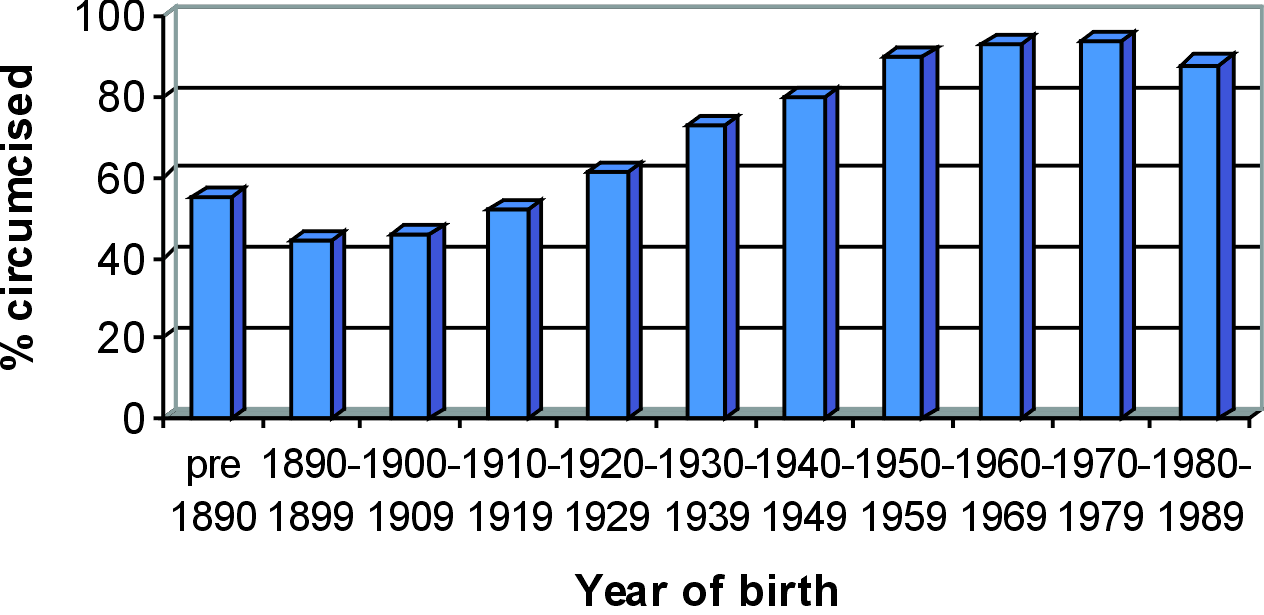
Estimates of circumcision rates among white American males 1890–1990. From Cox & Morris 2012
More influential, perhaps, was Dr P.C. Remondino, who was a major advocate for circumcision. His book, first published in 1891, was ostensibly a history of circumcision but carried the subtitle "Moral and Physical Reasons for the performance" and this actually takes up a lot of the book. But as the graph shows, by 1891 circumcision was already very common. Remondino was channeling the zeitgeist. He regarded the discovery of the medical benefits of circumcision as a purely American invention, and the man he credited for that was Dr. Lewis A. Sayre (whom he referred to as Louis). (Louis is often pronounced as Lewis in the USA).
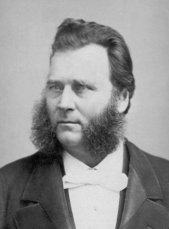 Lewis Albert Sayre (left), 1820-1900, of Bellvue Hospital, New York, was primarily an orthopaedic surgeon, and is regarded as the founder of the discipline in the US. He found that often what presented as orthopaedic problems, particularly in infants, were secondary symptoms caused by phimosis and balanitis. The infant would contort its limbs to minimise the pain from the infected member. He first published on this in 1870, but his best known paper appeared in 1888: "On the deleterious effects of a narrow prepuce and preputial adhesions". In it he quoted many examples sent to him by other doctors (many of these subsequently quoted more or less verbatim by Remondino). But there are several problems with calling him the father of modern American neonatal circumcision. First of all, like many other 19th century physicians, he only advocated the operation when there was an obvious problem. Secondly, his preferred operation on infants was a simple dorsal slit, without removing any tissue unless it was necessary. He only recommended full circumcision for boys of 10 or over and adults. In the subsequent discussion, Dr I.N. Love of St Louis took the dissenting view that a radical circumcision was the best course to take. "It is all very well to instruct the mother or the nurse to keep the parts within the prepuce clean but they cannot or they will not do it. Complete and proper removal of the covering to the glans takes away all the cause of disturbance." Sayre had commented that some infant circumcisions were cosmetically unsatisfactory, and Love replied "An improper performance of a surgical procedure is no argument against the operation, but rather against the operator" - an argument just as relevant now as then. It is Dr. Love who has the strongest case to be regarded as the father of modern American routine circumcision.
Lewis Albert Sayre (left), 1820-1900, of Bellvue Hospital, New York, was primarily an orthopaedic surgeon, and is regarded as the founder of the discipline in the US. He found that often what presented as orthopaedic problems, particularly in infants, were secondary symptoms caused by phimosis and balanitis. The infant would contort its limbs to minimise the pain from the infected member. He first published on this in 1870, but his best known paper appeared in 1888: "On the deleterious effects of a narrow prepuce and preputial adhesions". In it he quoted many examples sent to him by other doctors (many of these subsequently quoted more or less verbatim by Remondino). But there are several problems with calling him the father of modern American neonatal circumcision. First of all, like many other 19th century physicians, he only advocated the operation when there was an obvious problem. Secondly, his preferred operation on infants was a simple dorsal slit, without removing any tissue unless it was necessary. He only recommended full circumcision for boys of 10 or over and adults. In the subsequent discussion, Dr I.N. Love of St Louis took the dissenting view that a radical circumcision was the best course to take. "It is all very well to instruct the mother or the nurse to keep the parts within the prepuce clean but they cannot or they will not do it. Complete and proper removal of the covering to the glans takes away all the cause of disturbance." Sayre had commented that some infant circumcisions were cosmetically unsatisfactory, and Love replied "An improper performance of a surgical procedure is no argument against the operation, but rather against the operator" - an argument just as relevant now as then. It is Dr. Love who has the strongest case to be regarded as the father of modern American routine circumcision.
It is clear that at first there was a class - or wealth - distinction, as in the UK. Harold Speert's seminal paper of 1953 found that among boys born at the Sloane Hospital in New York 57% of ward (public) patients and 74% of private patients were circumcised. But in fact the difference was accounted for in the pre-war years - by the end of his study period circumcision rates were the same for both groups. However a 1985 study (Slaby & Drizd) still found a difference, with circumcision rates among white boys ranging from 39% among the lowest income group (<$1,000 pa) to 94.1% in the highest (>$15,000) - a pretty wide range. Overall the figure was 80% for white boys. Circumcision rates also depended on parents' educcational status, with more educated parents more likely to circumcise. Slaby & Drizd were reporting on boys aged 12 to 17, and noted that these figures were higher than those given by hospital discharge rates, so many boys were circumcised after leaving the maternity hospital. This should be remembered when looking at other figures, which are often based on hospital data.
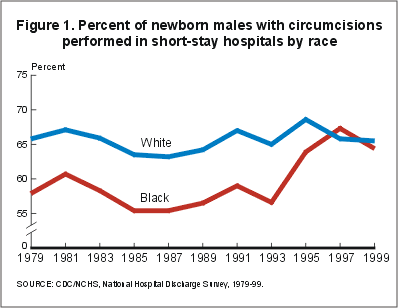
There were also differences by race. Slaby & Drizd found that only 45% of black boys were circumcised. This was not correlated with income, but the correlation with parental educational was still there. This was changing, though, as this graph from the National Hospital Discharge Survey in 1999 shows - by that year black Americans had caught up.
The HNDS is conducted annually by the National Center for Health Statistics (NCHS), a division of the Center for Disease Control. The data is in the public domain.
Hispanic people have the lowest circumcision rate in the US, and the highest rates of positive HIV status. It has been suggested that the apparent fall in circumcision rates shown in the graph above is largely a consequence of the influx of Hispanic immigrants and their higher birth rate, with no actual negative trend among white and black Americans. Camille Introcaso and her colleagues have given us the most recent study into this, based on data from the National Health and Nutrition Examination Surveys 2005-2010 (NHANES). 6294 men and boys aged 14 to 59 years took part. Overall circumcision rates peaked at 83.3% among those born between 1960 and 1969, and were significantly lower (76.2%) among the youngest group, born between 1990 and 1996. However there are more Hispanic men and boys in the later years, and looking just at non-Hispanic white and black Americans the peak rate was in boys born in the '70s, and the subquent decline was not significant. Overall, 90.8% of whites and 75.7% of blacks were cut, while only 44.0% of Mexican Americans were.
The Circumcision Bill
In 1956 congressman Charles Tobias introduced a bill proposing that all male babies born in the United States should be circumcised within 30 days of birth. The bill aimed to standardize circumcision for newborn males. It was based on the fact that circumcision had health benefits, including reducing the risk of urinary tract infections and penile cancer. The proposal intended to make circumcision the default option for all male infants.
Predictably, this faced opposition from many quarters and did not pass. But it is fascinating that it could have even been proposed. Thanks to Italian reader DP for (extensive) sleuthing to track this down.
What of the future?
In 1971 the American Academy of Pediatrics recommended against routine neonatal circumcision. Research since then made this position more and more untenable. The statement was modified in 1999 to acknowledge the medical benefits, but then much more radically in 2012, to state "preventive health benefits of elective circumcision of male newborns outweigh the risks of the procedure ... benefits of this procedure are sufficient to justify access to it for families choosing it and to warrant third-party payment for circumcision of male newborns." The CDC had earlier issued a statement recommending circumcision. In the light of these statements it seems certain that circumcisiom rates will rise again.
Americans have always been fond of gadgets - think about how many labour-saving devices we owe to US inventiveness. Couple this with their fondness for circumcision and it is only to be expected that they would devise gadgets to make circumcision simpler.
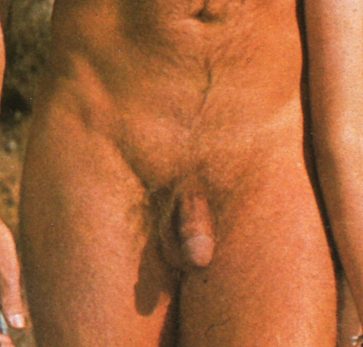
These are all described in our Instruments and Techniques page, so I will only mention the two most popular ones, and only in outline. The Gomco Clamp was introduced in 1935, though it had predecessors. It rapidly became the instrument of choice for routine circumcision in the USA, and even today is probably the most used device. It typically gives perfectly circular scars from 1 to 3 cm behind the glans, and a modest amount of skin movement - a style halfway between British and Aussie types, both in tightness and the amount of inner skin remaining. And that leads to the fact that skin and lube wanking are about equally popular in the US, whereas lube is almost unknown in the UK and pretty much universal in Australia. The Gomco has been exported but hasn't achieved anything like its US popularity overseas.
Detail of the father from a group photo of a Californian nudist family in H&E magazine (vol. 78 number 9 page 32). A beautiful circumcision showing the classic 'perfect circle' scar. Sadly the rest of the photo shows that he denied his son the benefits of circumcision. How could he do that?
The Plastibell, introduced 20 years later, is a disposable device which leaves a ring around the penis until the cut has healed. A nylon cord around the ring acts as a suture and so provides a more certain wound closure than the Gomco, but swelling trapped by the ring can cause discomfort and this seems to explain why adult versions of the device were soon withdrawn. Also, the frill of necrotic skin in front of the ring can occasionally be a source of trouble. The Plastibell is widely used in the US but it doesn't seem to have toppled the Gomco from top spot. However it has had wide success in export markets. It typically gives a looser result than the Gomco.
G Cox & BJ Morris, 2012. Why Circumcision: From Prehistory to the Twenty-First Century. Chapter 21 in: D.A. Bolnick et al. (eds.), Surgical Guide to Circumcision, Springer-Verlag London. 243-259
C E Introcaso et al., 2013. Prevalence of circumcision among men and boys aged 14 to 59 years in the United States, National Health and Nutrition Examination Surveys 2005-2010. Sexually Transmitted Diseases: 40, 521 - 525. Open Access
P C Remondino, History of circumcision from the earliest times to the present. Philadelphia: F.A. Davis, 1891
L A. Sayre, 1888. On the deleterious effects of a narrow prepuce and preputial adhesions. Transactions of the Ninth International Medical Congress, Vol.III Full text available here.
A R Slaby & T Drizd, 1985 Circumcision in the United States. American Journal of Public Health. 75:878–80.
H Speert, 1953. Circumcision of the newborn. An appraisal of its present status. Obstetrics & Gynecology. 2:164–72.
AcknowledgementsMany thanks to Professor Brian Morris for doing much of the literature search used in this page, and to JH for information on Sayre. And as ever thanks to Wikipedia, for the map, for the photo of Lewis Sayre and for the details of the Mississippian culture.